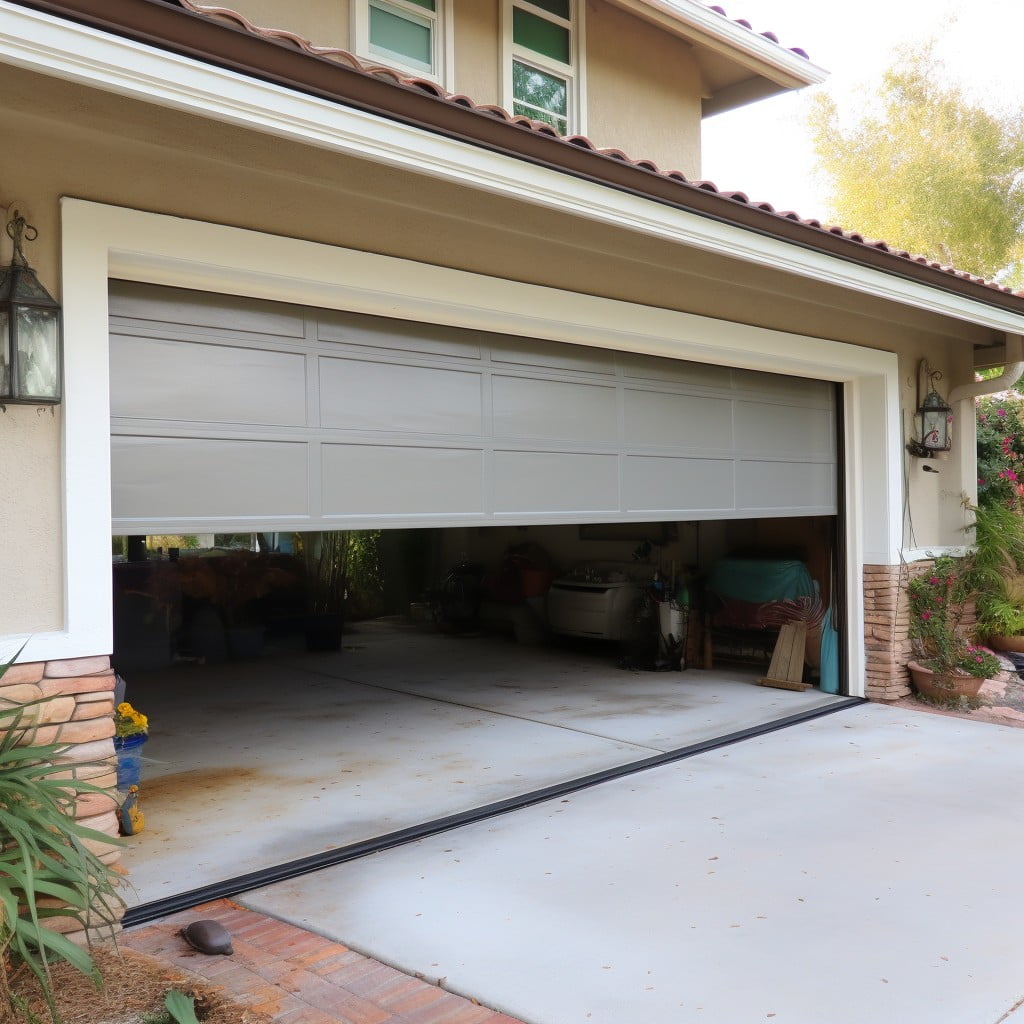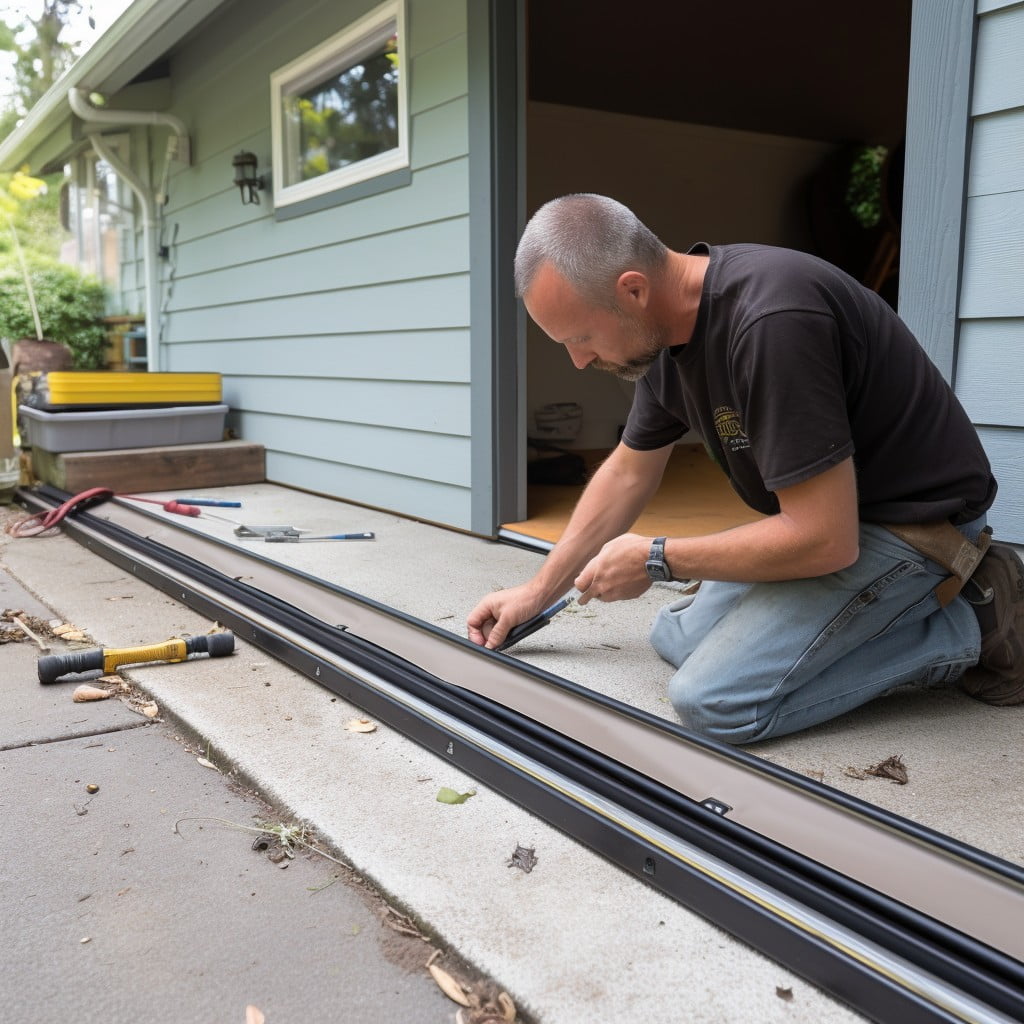Discover effective methods to seal gaps in your garage door, ensuring energy efficiency and protection from pests.
Sealing garage door gaps is an essential step in maintaining your garage’s efficiency and protecting it from external elements. This task, while seemingly daunting, can be accomplished with a few simple tools and steps.
This article will guide you through identifying the type of gap, choosing the right sealant, and the process of sealing the gaps effectively. By following these instructions, you can ensure that your garage door is as secure and energy-efficient as possible.
So, whether you’re dealing with gaps at the top, sides, or bottom of your garage door, rest assured, every detail you need is right here.
Key takeaways:
- Garage door bottom seal prevents dust, rain, and pests.
- Threshold seal attaches to garage floor for added protection.
- Adjust door gap with wrench and level for balance.
- Clear debris, measure gap, and install garage door bottom seal.
- Use weatherstripping seals to insulate sides of garage door.
Garage Door Bottom Seal

This type of seal, fashioned from rubber or vinyl, plays a pivotal role in maintaining a well-sealed garage door. Its job? To form a tight barrier between the garage floor and the door itself, preventing unwanted elements such as dust, rain, or pests from entering.
Replacing these seals when they wear down is essential. You can do this by detaching the old seal, measuring your garage door width for a new one, and finally, sliding the new seal into the track at the door bottom. Some kits also come with an adhesive for added security.
This simple, cost-effective method can make a world of difference in keeping your garage clean and dry.
Garage Door Threshold Seal

A threshold seal provides an effective, weather-tight barrier at the bottom of your garage door. Typically made from durable materials like vinyl or rubber, it is designed for heavy use and can withstand the weight of a vehicle. This type of seal is attached to the garage floor, rather than the door itself, helping to close any gaps left by an uneven floor surface.
Installation is relatively straightforward: you simply apply an adhesive directly to the floor, before laying down the seal. For the best results, it’s crucial that the floor is clean, dry, and level – the seal won’t adhere properly to a dirty or damp floor.
A threshold seal, besides insulating your garage from wind and rain, also keeps out rodents and insects. It aids in preventing dust and leaves from entering, and reduces noise levels too. Each threshold seal will have its own specific maintenance procedures, but in general, they require little upkeep beyond regular cleaning.
Remember, it’s worth taking the time to measure your garage door carefully before purchasing a threshold seal. This ensures the seal fits perfectly and works effectively.
How To Adjust A Garage Door Gap

Firstly, gather the necessary tools such as a wrench and a level. Close the door and inspect the gap. If it’s more significant on one side, the door might be out of balance. Loosen the screws on the garage door track slightly, just enough to allow for minor adjustments.
Use the level to ensure a plumb position as you gently slam the door against the frame. Then, retighten the screws keeping an eye on the level to maintain the door’s balance. If necessary, enlist a second person to help you with this process.
If a gap still prevails, consider adjusting the limit switches. They control how far up or down the door travels. Located on the garage door opener, they usually have up and down arrows. Make small adjustments until the door closes completely.
Finally, bear in mind that garage doors will wear out over time. This could manifest in sagging or warping, exacerbating the gaps. Regular maintenance and periodic replacement of worn parts can help prevent such issues.
Remember, if you’re uncomfortable performing these adjustments yourself, we strongly recommend seeking professional assistance.
How To Fill The Gap Between Garage Door And The Floor

Begin by clearing any debris from the garage door’s path to ensure a closer fit to the floor surface. Grime and detritus can often be a leading cause of unwanted space between the door and the floor.
Use a broom or a small handheld brush for this task and consider employing a vacuum to remove tiny particles. Make sure the area is completely clean before proceeding.
Once the floor is clean, measure the gap. Always remember the adage, “Measure twice, cut once.” This measurement will be used to obtain sealing material of the right size, thus eliminating guesswork.
Once you have ascertained the gap dimensions, it’s shopping time. Visit your local hardware store or browse online for a garage door bottom seal, also called an astragal. These seals are typically made of flexible rubber or vinyl and come in various sizes to suit your needs.
Installation of the seal is often a straightforward process. The seal slides into the track located at the bottom of the garage door and should fill the gap wonderfully, keeping out unwanted pests and weather elements. For larger gaps, consider installing a threshold seal along the garage floor for added protection.
Remember, while this process may seem daunting initially, taking this step-by-step approach and focusing on accuracy and quality will result in a finished product that not only serves its purpose but improves the overall functionality and look of your garage.
Sealing a Garage Door At the Bottom
To ensure effective sealing at the bottom of the garage door, it’s important to choose the right type of seal. There are several types to consider including rubber seals, thresholds seals, and door sweeps.
Rubber seals are considered highly durable and provide excellent insulation against external elements. They attach directly to the bottom of the door, providing a tight barrier against water and pests.
Threshold seals, on the other hand, are installed on the garage floor rather than on the door. This type of seal can fill larger gaps and works well for uneven floors.
Door sweeps offer a physical guard against debris and small rodents. They get installed on the inside or outside of the door creating a solid barrier when the door is closed.
In all cases, ensure that the seal is installed properly and covers the entire width of the door. Follow the manufacturer’s instructions for the best results. Regular inspection and maintenance are necessary to keep the seal in good condition.
Sealing the Sides of a Garage Door
It’s a common misstep to overlook the sides of the garage door when addressing gaps. However, these areas are just as integral to maintain to ensure an energy-efficient, weather-resistant space.
Insulating the sides, also known as the garage door tracks, can be achieved by using weatherstripping seals. Weatherstripping comes in various types such as peel & stick, adhesive-backed foam, or V-strip, which you choose will be dependent on your door type and personal preference.
The installation process is straightforward. It requires cutting the weatherstripping to the length of the door, then attaching it to the outer edge so it forms a barrier when the door is closed. A quick tip: operate the door a few times to ensure it doesn’t interfere with the opening and closing mechanism.
Remember, cleaning the garage door and its tracks by removing dust or debris beforehand will promote better adhesion of the weatherstripping seals. This simple yet effective method will greatly reduce those pesky drafts and keep pests at bay.
Sealing the Top of a Garage Door
When sealing the top of a garage door, several considerations should be made.
1. Measure Accurately: An accurate measurement is essential in ensuring that the seal is the proper length. Use a reliable measuring tool for obtaining precise dimensions.
2. Choose the Right Seal Type: There are numerous seal types such as brush seals, bulb seals, and rubber flap seals. Brush seals are ideal for uneven surfaces while bulb seals offer a firm closure.
3. Check Existing Seal: Most garage doors come with a pre-installed seal. It’s crucial to determine if the current seal is salvageable or requires replacement.
4. Secure Seal: Once the seal type is selected, fasten it securely to ensure it stays in place and performs effectively. Screws or nails can be used for anchoring.
5. Test Door Operation: After installation or adjustment, open and close the door several times to ensure the seal doesn’t interfere with its smooth operation.
By adhering to these key points, the top of your garage door will be effectively sealed, leading to enhanced energy efficiency and improved garage security.
Materials Needed for Sealing Garage Door Gaps
To successfully seal garage door gaps, a few critical supplies are necessary.
1. Quality Weatherstripping – Weatherstripping comes in various forms, such as adhesive strips, door sweeps, or threshold seals, and is the primary material to block any door gaps effectively.
2. Sealant or Caulk – A waterproof, flexible, and durable sealant can help reinforce your weather stripping for an added layer of protection.
3. Tape Measure and Level – To ensure the correct placement and alignment of your seal, these tools are vital.
4. Utility Knife – This is useful for cutting excess sealant or weatherstripping to fit your door dimensions perfectly.
Remember, opting for the best quality materials you can afford is important as it ensures better performance and longer-lasting results.
FAQ
Should I caulk around garage door?
Yes, you should not caulk around garage door as the panels are designed to move and require room for free-play.
What type of weather stripping is most efficient for garage doors?
Vinyl weather stripping is the most efficient for garage doors due to its high durability and resistance to temperature changes and extreme weather conditions.
How can garage door bottom seals be effectively replaced?
Garage door bottom seals can be effectively replaced by removing the old seal, measuring and cutting a new one to size, and then installing it by sliding it into the track or affixing it with screws or adhesive, ensuring it forms a tight seal against the ground to prevent drafts, rodents, and water intrusion.
Which materials are best suited for sealing gaps in a garage door?
For sealing gaps in a garage door, weatherstripping, door seals, and threshold seals are the best materials to use.